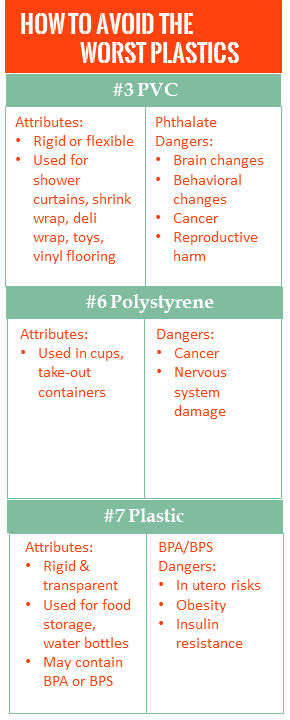How to Avoid the Very Worst Plastics

Do you need a refresher on which plastics to avoid? You know that some are worse than others, but it’s hard to keep it straight, isn’t it? Wouldn’t it be great to have a simple list of the worst plastics along with some helpful tips?
Well, it’s here. That simple list of the very worst plastics and ways to avoid them.
The Three Worst Plastics
Avoid Plastic #3 PVC or Polyvinyl Chloride
Check your plastic container. Do you see a #3 or the acronym PVC? Try to avoid this type of plastic.
PVC or vinyl can be rigid or flexible. It is used to make shower curtains, shrink-wrap, deli wrap, plastic toys, and vinyl flooring. PVC has toxic chemicals including phthalates.
So what are phthalates?
Phthalates are a family of chemicals used to soften plastics and other products.
Here’s the problem. Phthalates are toxic and are increasingly linked to brain, behavior changes, cancer and reproductive system harm.
And, phthalates are also linked to asthma.
Enough said.
How to Protect Yourself From #3 Plastic
1. Opt for non-vinyl shower curtains.
2. Remove foods in plastic wrap and place in glass containers to store.
3. Avoid buying plastic toys made with #3 especially ones that children place in their mouths.
4. Purchase safer vinyl flooring or opt for healthier alternatives. Try bio-based linoleum, natural rubber, and ceramic tile.
Read more about toxic vinyl flooring and which brands are healthier.
Avoid Plastic #7
Plastic #7 is really a catch-all. It may contain BPA or BPS. Some manufacturers advertise BPA-free which is better for you, but it’s best to try to avoid these plastics.
Number 7 plastics are rigid and transparent and are commonly used for food storage and water bottles. BPA can migrate from the containers particularly if used for hot foods or liquids.
Why should you care about BPA and BPS?
BPA and BPS pose risks in utero as well as risks to children and adults. Research has linked higher BPA exposure with obesity in adults while another study found that BPA is associated not only with obesity but also with insulin resistance. And, insulin resistance leads to disease.
How to Protect Yourself From #7 Plastic
1. Discard any plastic container that is scratched or cloudy because the plastics chemicals can leach into your food or drink.
2. Replace with plastic food storage containers with glass. You’ll love the glass containers and wonder why you ever used plastic.
3. Use glass or stainless steel reusable water bottles. If opting for stainless, make sure there is no epoxy lining.
4. Never heat your food in the microwave using plastic containers or plastic wrap. Use glass and cover with a paper towel.
Avoid Plastic #6 Polystyrene
Known as Styrofoam, you’ll find #6 in cups, plastics, take-out containers and more. Styrene can leach into your food. Studies link it to cancer and nervous system damage.
Higher temperatures result in more styrene leaching from the container into your food. Try not to think about those cups of coffee you’ve had in a Styrofoam cup.
It’s a troubling thought, isn’t it?
How to Protect Yourself From #6 Plastic
1. Avoid drinking hot beverages in Styrofoam cups. If your office only offers Styrofoam, then use your own mug.
2. Remove take-out from the plastic containers as soon as you can. Store take-out leftovers in glass containers.
What’s Next?
Now you’re loaded with tips for avoiding the worst plastics. Remember, avoid #3, #6 and #7.
So, what’s next?
Are you still drinking tap water? or bottled water? Read The Beginner's Guide to Water Filtration. It might just change your mind.
Please share.
Sign up for the newsletter! Get the FREE bonus – The Safest Cleaning & Laundry Product Shopping List. Don’t go shopping without it.





